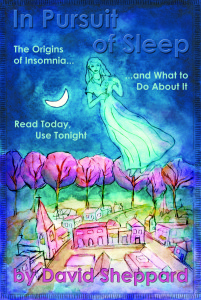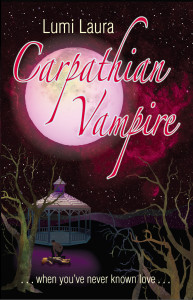(UPDATE: Publication of In Pursuit of Sleep has been rescheduled for early January 2016.)
From the author:
This book is an outgrowth of sixty-five years of experimentation and research. I’ve had difficulty sleeping since I was a kid. At the age of eight, I had an imaginary girlfriend who went on adventures with me while I waited for sleep to overtake me. My father was a farmer and prone to worry over product prices and the weather, things he could do nothing anything about. I absorbed a certain amount of his insomnia and worry, and passed it along to my kids. This same story with different characters plays out every night throughout the world, and by all reports is getting worse because of the accelerating pace and complexity of modern life. This book is my attempt at turning the tide.
If you’ve been lying awake at night waiting helplessly for sleep to come, it is time you went on the offensive. This book is about pursuing sleep. It presents all the information you need to chase sleep all the way to Slumberland. This book is not about tricking yourself into going to sleep. The method developed herein is based on scientific principles and years of research into the problems that block sleep. It builds off of what we know about sleep and the way the mind works while negotiating that gray zone between being awake and asleep. It does not involve medication. And it doesn’t take weeks of learning before you can get started. Read this today, use the method tonight.
I’m an author and an engineer with an MS from Stanford University. I have written nine books, both fiction and non-fiction, two of them on the creative process and the inter-workings of the mind close to the sleep state. I’ve experimented with dreams and lucid dreaming and how to use them creatively. I have developed a method for dealing with insomnia. Will it work for you? Perhaps. This approach isn’t something you’ll find in the literature, and it doesn’t involve medication. It doesn’t depend on meditation either. It is completely new.
If you have a job or little ones to care for, you need good sound sleep. Sleep interruptions can occur at any time during the night. Your child can wake you. You might have to go to the bathroom. Your sleeping partner can wake you for any one of a number of reasons. How do you get back to sleep under these circumstances? Perhaps this method will help you get the sleep you so badly need to get you through the day.
I’ve only taken three types of medication to get to sleep, two self-medicated and one under prescription from a doctor. The first I tried was melatonin, which is a hormone involved in circadian rhythms. It seemed to have no effect. For a couple of years I took Benadryl, three capsules at bedtime and two the first time I woke, about four or five hours later. Benadryl helped some, but I didn’t like taking so much since it does have side effects.
For six months while teaching astronomy at a university, I took Ambien, which worked well enough but didn’t seem to give me the kind of sleep I needed. When I went off it, I had ocular migraines every day for a couple of weeks. I had large blotches in my field of vision and blank spots where I could see nothing. For six months after quitting, I also had difficulty getting to sleep when I first went to bed much worse than before I took Ambien.
I started researching solutions for insomnia seriously in December 1990. I had been using all the “tricks,†like counting sheep and trying to keep my eyes open. I investigated cognitive behavior therapy, sleep hygiene, and tried meditation techniques to clear my mind of thoughts. None of it had a measurable impact. I was an engineer working on NASA missions to the outer planets and US Air Force Projects. I was also an author writing novels and accumulating material on the creative process. I became interested in the periods just before and after sleep because they seemed to be inordinately useful for many authors as well as other creative people. I developed a method of taking my characters into my dreams, and I developed work strategies and solutions for difficult engineering tasks. Sixteen years ago, I started exploring scientific literature on the period of time just before sleep and discovered a complete world of information under the title of “hypnagogia.†I then started the development of a method to solve my insomnia problem.
I am a professional but not a sleep professional, and apparently that is a good thing. Little or no rigorous research has been accomplished on techniques to direct the mind to enter sleep. Sleep research has been predominantly performed, or at least paid for, by pharmaceutical companies into medication to make the subject unconscious. This usurps the natural processes involved in going to sleep and does not achieve the same result as the patient actually being asleep. All the same, I do not recommend that you quit taking any medication that a doctor has prescribed for you. We do have extensive psychotherapy procedures to resolve psychiatric issues that flood into consciousness and co-opt the process of going to sleep, but this isn’t even necessarily the problem, and therapy can take years and have mixed results. I know because I have been there. An online search will quickly reveal methods for producing an environment conducive to sleep and even some superficial methods of tricking your mind into going to sleep. My guess is that none of them work reliably for you or you wouldn’t be reading this.
The other thing that has helped greatly in the writing of this book is that I went through five years of psychotherapy with psychiatrist. At the time, I was going through all sorts of problems, from troublesome relationships to panic attacks. I had fears of dying in my sleep. I had trouble sleeping. Although the therapy was helpful in many ways and my therapist was very good, I also came to realize the limitations. I walked away with many of the problems I came to it with, and getting to sleep was one of them. I even came away with a few problems I didn’t have when I entered therapy. As my psychiatrists told me, every treatment has it side effects, even therapeutic treatment.
What I present here appears to be the first serious research into methods to direct the mind along a path into sleep. My most fervent wish is that this book will prod sleep professionals to start research into directing the mind toward sleep. Perhaps then we, as a world of the sleep deprived, can actually do something about our insomnia without being drugged.
Will this be the answer for everyone? Probably not. Many people have more serious problems with sleep than the ones I present a solution for here. Some have brain damage and chemical imbalances. They will have to rely on professional medical help. However, I contend that any normal human being, even while suffering all the stresses of modern life, should still be able to get to sleep in less than five minutes. That certainly has been my experience.
After a year or so of practicing this technique, which I call the Transition Trek, I just let my mind freewheel to remind me how I used to try to get to sleep. Took me about an hour, when now I can get to sleep easily in less than a minute. Waiting for sleep is such a messy and ineffective way to get where you are going. It is like standing on a corner waiting for a bus when you don’t know the bus schedule or even if a bus comes down this street. You don’t “fall†asleep. Sleep doesn’t come get you. Sleep is waiting on you to come for it. I am going to show you how to go get it












